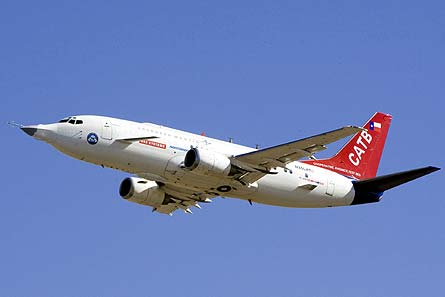BAE Systems looks set to receive additional flight clearances for its modified Boeing 737-300 avionics test bed for the Lockheed Martin F-35 Joint Strike Fighter (JSF), which recently flew after completing a three-year mission to convert the airliner into a military systems laboratory.
The Joint Strike Fighter Cooperative Avionics Test Bed (CAT-Bird), modified by BAE Systems, completed its maiden flight in late January in Mojave, California. CAT-Bird is a flying test bed that replicates the F-35 avionics suite, whose integration is being led by BAE.
The aircraft includes an F-35 cockpit installed with sensor inputs to be displayed as they would be in the fighter itself. The rest of the interior houses equipment racks for the avionics equipment, and 20 workstations for technicians to assess the performance of the avionics, BAE says.
However, certain aerodynamic changes were also made to the airframe of the converted airliner and requires a supplementary type certificate before it can extand its flight envelope. These modifications include the addition of a nose extension to simulate that of the F-35, a 12.7m (42ft) spine on the top of the fuselage, a 3m canoe-shaped pod on the bottom to accommodate electronics and twin 3.6m sensor wings that replicate the leading edge of the F-35’s wings (pictured below).
|
|---|
“The CAT-Bird is a vitally important and powerful tool in Lockheed Martin’s arsenal for early risk mitigation and maturation of the F-35,” said Doug Pearson, Lockheed Martin’s vice president of the F-35 Integrated Test Force. “It allows us to concurrently develop and integrate mission systems hardware and software well before it is installed on F-35s. We congratulate BAE Systems on the successful first flight and look forward to many years of productive flight test operation.”
The CAT-Bird has completed eight test missions and logged 24.8h and is now set to receive additional flight clearance.
“The CATBird test programme is executing to plan, with no significant issues,” said Dan Crowley, Lockheed Martin executive vice president and F-35 programme general manager. “We will now open up the flight envelope, which is within the 737’s operating limits.”
The avionics suite to be used in production F-35s includes:
- BAE Systems Avionics - side stick and throttle controls
- Vision Systems International (a joint venture between Kaiser Electronics and Elbit of Israel) - advanced helmet-mounted display
- BAE Systems Platform Solutions - alternative design helmet-mounted display, based on the binocular helmet being developed for the Eurofighter Typhoon
- Ball Aerospace - Communications, Navigation and Integration (CNI) integrated body antenna suite (one S-band, two UHF, two radar altimeter, three L-band antennas per aircraft)
- Harris Corporation - advanced avionics systems, infrastructure, image processing, digital map software, fibre optics, high-speed communications links and part of the Communications, Navigation and Information (CNI) system
- Honeywell - radar altimeter, Inertial Navigation / Global Positioning System (INS/GPS) and air data transducers
- Raytheon - 24-channel GPS with Digital Anti-jam Receiver (DAR)
Read Flight's JSF special....
Source: FlightGlobal.com




















